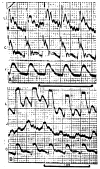The effect of blood vessel pulsations on lymph pressure in large lymphatics
- PMID: 13115807
- PMCID: PMC2981401
The effect of blood vessel pulsations on lymph pressure in large lymphatics
Figures




Similar articles
-
Mechanical forces and lymphatic transport.Microvasc Res. 2014 Nov;96:46-54. doi: 10.1016/j.mvr.2014.07.013. Epub 2014 Aug 5. Microvasc Res. 2014. PMID: 25107458 Free PMC article. Review.
-
Characteristics of the active lymph pump in bovine prenodal mesenteric lymphatics.Lymphat Res Biol. 2007;5(2):71-9. doi: 10.1089/lrb.2007.5202. Lymphat Res Biol. 2007. PMID: 17935475
-
Lymphatic and blood systems: Identical or fraternal twins?Int J Biochem Cell Biol. 2019 Sep;114:105562. doi: 10.1016/j.biocel.2019.105562. Epub 2019 Jul 3. Int J Biochem Cell Biol. 2019. PMID: 31278994 Review.
-
Mechanics of Lymphatic Pumping and Lymphatic Function.Cold Spring Harb Perspect Med. 2025 Mar 3;15(3):a041171. doi: 10.1101/cshperspect.a041171. Cold Spring Harb Perspect Med. 2025. PMID: 38692743 Review.
-
The second valve system in lymphatics.Lymphat Res Biol. 2003;1(1):25-9; discussion 29-31. doi: 10.1089/15396850360495664. Lymphat Res Biol. 2003. PMID: 15624318 Review.
Cited by
-
Pressure-Flow Relation of Porcine Thoracic Duct Segment.Bioengineering (Basel). 2025 Apr 9;12(4):401. doi: 10.3390/bioengineering12040401. Bioengineering (Basel). 2025. PMID: 40281761 Free PMC article.
-
Intrinsic rhythmic propulsion of lymph in the unanaesthetized sheep.J Physiol. 1965 Sep;180(2):336-49. doi: 10.1113/jphysiol.1965.sp007706. J Physiol. 1965. PMID: 5857113 Free PMC article. No abstract available.
-
Studies of ulceration and edema of the lower extremity by lymphatic cannulation.Ann Surg. 1959 Jun;149(6):884-96; discussion 896-7. doi: 10.1097/00000658-195906000-00012. Ann Surg. 1959. PMID: 13650475 Free PMC article. No abstract available.
-
The relationship between lymphangion chain length and maximum pressure generation established through in vivo imaging and computational modeling.Am J Physiol Heart Circ Physiol. 2017 Dec 1;313(6):H1249-H1260. doi: 10.1152/ajpheart.00003.2017. Epub 2017 Aug 4. Am J Physiol Heart Circ Physiol. 2017. PMID: 28778909 Free PMC article.
-
Arterial pulsation and lymph formation in an isolated sheep hindlimb preparation.J Physiol. 1988 Nov;405:595-604. doi: 10.1113/jphysiol.1988.sp017350. J Physiol. 1988. PMID: 3255801 Free PMC article.
References
-
- Cressman RD, Blalock A. The effect of the pulse upon the flow of lymph. Proc Soc Exp Biol and Med. 1939;41:140.
MeSH terms
Grants and funding
LinkOut - more resources
Full Text Sources
